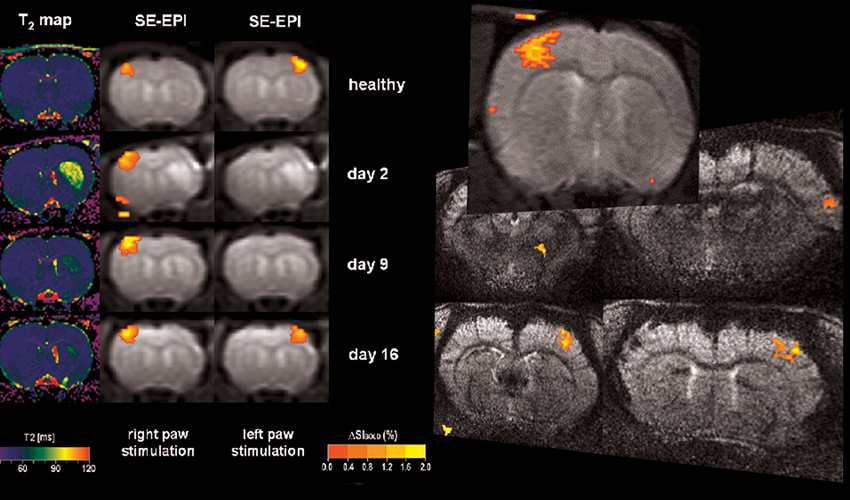“Free Informative Webinar - Functional and Morphological MRI of the Heart and Brain in Small Animal Imaging - May 27 2014”
Overview
To effectively study cardiac morphology and function, or follow neuroinflammatory processes in the brain, image quality is everything. The current capabilities of cardiac and brain MRI in mice are being significantly enhanced by cryogenically-cooled technology, which is proving invaluable to researchers around the world.
Join Professor Thoralf Niendorf (Berlin Ultrahigh Field Facility, Max-Delbrueck Center for Molecular Medicine, Berlin, Germany) and Bruker as we demonstrate, in a 45 minute webinar, the powerful potential for enhanced resolution with the use of a cryogenically-cooled RF coil. The MRI CryoProbe™ delivers significant signal-to-noise (SNR) gains of a factor of 3.0 to 5.0 over conventional room temperature coils, directly boosting spatio-temporal resolution to provide sufficient detail to expand the study of cardiac morphology and function, as well as neuroinflammatory processes in the brain.
What you will learn
Cardiac morphology and function assessment of mice by magnetic resonance imaging is of increasing interest for a variety of mouse models in preclinical cardiac research, such as myocardial infarction models or myocardial injury/remodeling in genetically or pharmacologically induced hypertension.
With standard room temperature coils, signal-to-noise ratio (SNR) constraints limit image quality and blood myocardium delineation, which crucially depend on high spatial resolution. The markedly improved image quality with the use of the MRI CryoProbe – by better delineation of myocardial borders and enhanced depiction of papillary muscles and trabeculae – facilitates more accurate cardiac chamber quantification, due to reduced intra-observer variability (1).
A comprehensive view of brain inflammation during the pathogenesis of autoimmune encephalomyelitis (EAE) can be achieved with the aid of high resolution non-invasive imaging techniques. With the MRI CryoProbe, inflammatory infiltrates within various regions of the brain can be studied in detail – even without the use of contrast agents – and show excellent correspondence with conventional histology.
This opens up a real opportunity to follow neuroinflammatory processes even during the early stages of disease progression. High-resolution MRI not only complements conventional histology, but also enables longitudinal studies of the kinetics and dynamics of immune cell infiltration (2-4).
Who should attend
Preclinical imaging scientists working in MRI, operators of preclinical CRO’s and anyone researching:
• Preclinical cardiac studies
• Myocardial infarction models
• Myocardial injury/remodeling
• Preclinical neuro-inflammatory models
• Preclinical immune cell infiltration
Presenter
Prof. Thoralf Niendorf, Ph.D.
Berlin Ultrahigh Field Facility, Max-Delbrueck Center for Molecular Medicine, Berlin, Germany and Chair for Experimental Ultrahigh Field Magnetic Resonance, Charité – University Medicine, Berlin, Germany
Moderator
Dr. Tim Wokrina
Product Manager, Bruker BioSpin MRI
Register online
Tuesday, May 27
Session 1
10:00 AM Berlin / 1:30 PM New Delhi / 4:00 PM Beijing
Register for Session 1
Session 2
8:00 AM San Francisco / 11:00 AM Boston / 5:00 PM Berlin
Register for Session 2
Can’t make the live webcast?
Register now and we’ll send you the webinar slides and a link to the recording to view later at your convenience. All are welcome and there is no charge to attend.
References:
1. Wagenhaus B, Pohlmann A, Dieringer MA, Els A, Waiczies H, Waiczies S, Schulz-Menger J, Niendorf T. Functional and morphological cardiac magnetic resonance imaging of mice using a cryogenic quadrature radiofrequency coil. PLoS One 2012;7(8):e42383.
2. Waiczies H, Guenther M, Skodowski J, Lepore S, Pohlmann A, Niendorf T, Waiczies S. Monitoring dendritic cell migration using 19F / 1H magnetic resonance imaging. J Vis Exp 2013(73):e50251.
3. Lepore S, Waiczies H, Hentschel J, Ji Y, Skodowski J, Pohlmann A, Millward JM, Paul F, Wuerfel J, Niendorf T, Waiczies S. Enlargement of cerebral ventricles as an early indicator of encephalomyelitis. PLoS One 2013;8(8):e72841.
4. Waiczies H, Millward JM, Lepore S, Infante-Duarte C, Pohlmann A, Niendorf T, Waiczies S. Identification of cellular infiltrates during early stages of brain inflammation with magnetic resonance microscopy. PLoS One 2012;7(3):e32796.





